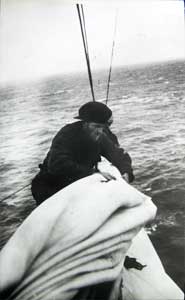How Do You Know He's a Sailor?

There is a stereotype of the English-speaking seafarer—the well-known Jack Tar. The Maritime History Archive's Crew Agreements show the inaccuracy of this caricature by revealing the diversity of the crews of merchant vessels. The number and variety of the seafarers who made up the crew of any deep sea vessel are much richer than just Jack Tar. Historically, seafarers have been made familiar to land dwellers in this single representation: a drunk and a womanizer, perhaps a malingerer who couldn't hold down a job ashore (Alexander, 4). But such propositions limit understanding of the identities that seafarers formed, and which each generation of sea-goers reconstructed. The variety of seafarers and the fact of technological change, namely the introduction of steam, make crew members a fascinating population to study in the period of the Crew Agreements and Logs.
Even on a traditional sailing ship crew ranged from the master and mate, to the bos'un (boatswain)—the petty officer in charge of many of the day-to-day operations of a ship—to Able-Bodied and Ordinary Seamen (A.B.s and O.S.s). Our heading "How Do you know he's a sailor" thus provokes the realization that not all seafarers were male or worked under sail.
Seafarers varied remarkably in background and ethnicity. Some merchant ships were ethnically diverse, consisting of men from many parts of the world: Indians, Chinese, Arabs and Africans. Some may have been able to communicate in languages other than their own and they were perhaps able to understand basic orders in English. Natives of colonized nations were hired because they were cheap labor. Because of Britain's economic and political control of India, Indian seamen were employed in large numbers on British merchant ships. They were widely referred to as "lascars."
But, as you will see, the greatest dividing line between the people who identified themselves as seafarers came with the technological difference between sailing by wind power, a force that could neither be created nor entirely controlled, and being propelled by steam, a force that could be both created and controlled. Sail and steam required different skill sets. New occupations emerged such as engineer and fireman, while traditional roles became marginalized and, in some cases, were made obsolete. Racial and ethnic distinctions continued but during the steam transition their boundaries shifted and their meanings changed.
